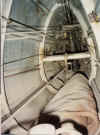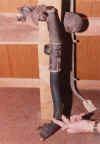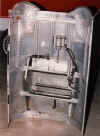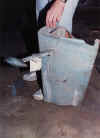| The following
brief history of this airframe has kindly been provided by Richard Corey
(via Dave McDonald).
Messerschmitt 109G-10 /
U4 W.Nr.610937
Built in 1944 by WNF most
likely as a G-14 , but upgraded to a G-10/U4 ‘Jabo-Rei’ in December
1944. Abandoned at Zeltweg airfield in Austria at the end of the war , her
original tactical markings will probably never be known. She could have
been from a Luftwaffe unit or just as likely a Hungarian one , as both
countries were using this airfield at the time.
Between May and August
1945, 610937 and many other aircraft were taken as trophies by units from
the 6th Polk, (regiment) of the Bulgarian Air Force and ferried to
Bulgaria , via Pech airfield , Hungary and Belgrade , Yugoslavia. Little
is is known about the service history of these Bulgarian Me-109s. Many
were transferred from the Karlovo airfield to the Burshen airfield near
Silven and were actively flown by the 2nd and 3rd Orlyak (group) of the
6th Polk until they converted to Yak-9. Some 109s went on to serve in the
training role as late as 1950, with the last of them being scrapped in
1951.
In 1947, the Paris
Peace Treaty limited the size of Bulgaria's Air Force and some of its
excess aircraft were sent to Yugoslavia in military equipment trade
negotiations between the two countries. 610937 became part of a shipment
of 59 Me109s to be traded for a number of fuselages and tail units of Il-2
Sturmoviks. After being transported to Zagreb by rail, the aircraft were
refurbished, repainted and 610937 became “White 44”, Yugoslav Air
Force s/n 9644. White 44 was flown by either the 83rd or 172nd fighter
wing based at Cerklje Airfield and may have been flown on patrol sorties
along the Italian frontier during the confrontation between Yugoslavia and
Italy over the free zone of Trieste. White 44’s last recorded flight was
October 17, 1950. Total flight time in service: 35 hrs.15 mins.
The aircraft was
placed in storage until 1953, when it was declared scrapped and donated to
a technical school known as the ‘Machine Facility ‘ in Belgrade. Then
used as an instructional airframe until 1979 , after which time she was
transferred to the Yugoslav Aviation Museum in Belgrade , being placed in
storage. In the early eighties the museum was struggling to pay the
heating bill , and since a fully restored G-2 was already on display , a
deal was struck which saw her being purchased for Doug Arnold’s Warbirds
of Great Britain Collection.
.In 1989 she was
resold to Evergreen Ventures and in 1991 sent to Vintage Aircraft
Restorations Ltd. at Ft. Collins, Colorado where , after 5 years , she was
restored to flight worthy condition . It is thought that the aircraft is
fitted with wings from a Buchon , obtained from Dave Tallichet.
Unfortunately little thought was given to the history of the aircraft with
no attempt made to research the markings that may have been hidden under
the Bulgarian and Yugoslavian AF paint . The skins were replaced and sent
directly to the scrap yard in order to make her ‘structurally sound ‘
for flight , something that has never been attempted , and at this time ,
seems unlikely to be. She was painted to represent an aircraft flown by
Germany's leading ace, Eric Hartman and is on display in preserved
condition (fluids drained) at the Captain Michael King Smith Evergreen
Aviation Educational Institute in McMinnville, Oregon.


Take special note of the wheels and wheel
wells in the photos above from Jim Penhale; it appears these are Buchon
wheels and wings. Sad...
|
































|